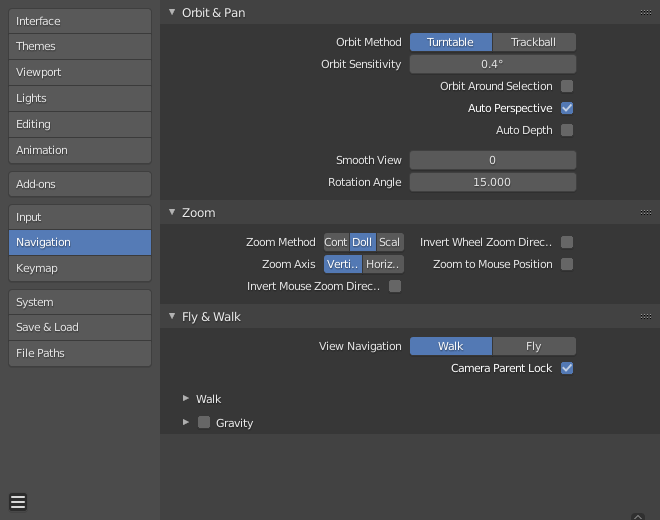Navigation¶

Blender Preferences navigation section.
Orbit & Pan¶
- Orbit Method
Choose you're preferred method of interactively rotating the 3D Viewport.
- Turntable
Rotates the view keeping the horizon horizontal.
This behaves like a potter's wheel or record player where you have two axes of rotation available, and the world seems to have a better definition of what is "Up" and "Down" in it.
The drawback to using the Turntable style is that you lose some flexibility when working with your objects. However, you gain the sense of "Up" and "Down" which can help if you are feeling disoriented.
- Trackball
- Is less restrictive, allowing any orientation.
- Orbit Sensitivity
Adjusts the reactivity/speed of orbiting in the 3D Viewport. This setting works differently depending on what Orbit Method is used:
- Turntable: Orbit Sensitivity control the amount of rotation per-pixel to control how fast the 3D Viewport rotates.
- Trackball: Orbit Sensitivity as a simple factor for how fast the 3D Viewport rotates.
- Orbit Around Selection
The selection center becomes the rotation center of the viewport. When there is no selection the last selection will be used.
This uses the selected object (bounding box center), in object mode and select elements in edit/pose modes.
注釈
While this may seem like ideal behavior, it can be inconvenient for larger objects such as a terrain mesh, where the center is not necessarily a point of interest.
- Auto Perspective
When enabled, the view switches to perspective when orbiting the view, setting axis views (Top/Side/Front/Back ... etc), sets the view to orthographic.
When disabled, orthographic/perspective mode needs to be changed manually.
- Auto Depth
- Use the depth under the mouse to improve view pan, rotate, zoom functionality. Useful in combination with Zoom To Mouse Position.
- Smooth View
- Time (in milliseconds) the animation takes when changing views (Top/Side/Front/Camera...). Reduce to zero to remove the animation.
- Rotation Angle
- Rotation step size in degrees, when Numpad4, Numpad6, Numpad8, or Numpad2 are used to rotate the 3D View.
Zoom¶
- Zoom Method
Choose your preferred style of zooming in and out, when using interactive view zoom.
- Scale
- Scale zooming depends on where you first click in the view. To zoom out, move the cursor to the area center. To zoom in, move the cursor away from the areas center.
- Continue
The Continue zooming option allows you to control the speed (and not the value) of zooming by moving away from the initial cursor position.
Moving up from the initial click point or to the right will zoom out, moving down or to the left will zoom in. The further away you move, the faster the zoom movement will be. The directions can be altered by the Vertical and Horizontal radio buttons and the Invert Zoom Direction option.
- Dolly
- Dolly zooming works similarly to Continue zooming except that zoom speed is constant.
- Zoom Axis
The axis of the mouse to use for zooming.
- Vertical
- Moving up zooms out and moving down zooms in.
- Horizontal
- Moving left zooms in and moving right zooms out.
- Invert Zoom Direction
- Inverts the Zoom direction for Dolly and Continue zooming.
- Invert Wheel Zoom Direction
- Inverts the direction of the mouse wheel zoom.
- Zoom to Mouse Position
When enabled, the mouse pointer position becomes the focus point of zooming instead of the 2D window center. Helpful to avoid panning if you are frequently zooming in and out.
ちなみに
This is useful in combination with Auto Depth to quickly zoom into the point under the cursor.
Fly & Walk¶
- View Navigation
The default mode for interactive first person navigation.
See Fly/Walk モード.
- Camera Parent Lock
When the camera is locked to the view, the root parent is transformed rather than the camera.
ちなみに
This is useful for camera rigs where you don't want to animate the camera directly.
Walk¶
- Reverse Mouse
- Inverts the mouse's Y movement.
- Mouse Sensitivity
- Speed factor for when looking around, high values mean faster mouse movement.
- Teleport Duration
- Interval of time warp when teleporting in navigation mode.
- Walk Speed
- Base speed for walking and flying.
- Speed Factor
- The multiplication factor for the speed boost.
Gravity¶
Simulates the effect of gravity when walking.
- View Height
- The distance from the ground floor to the camera when walking
- Jump Height
- The maximum height of a jump.